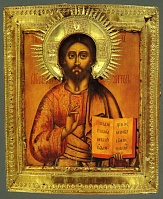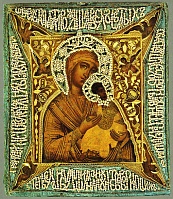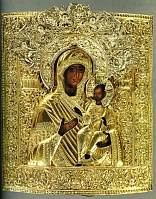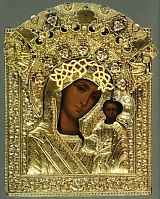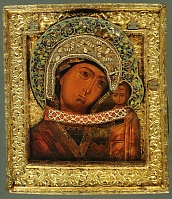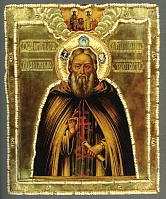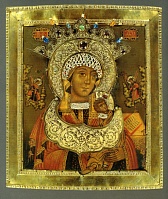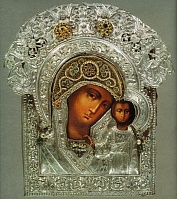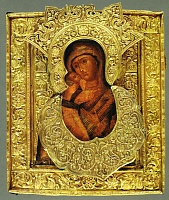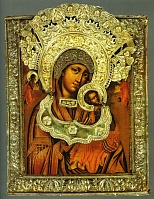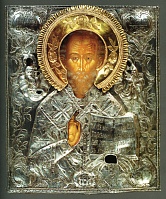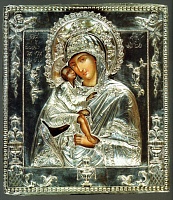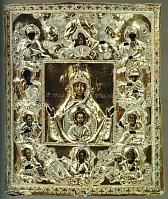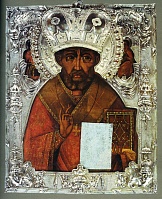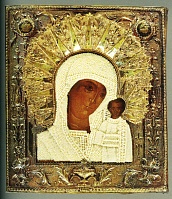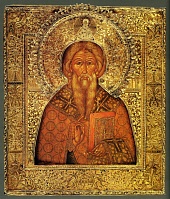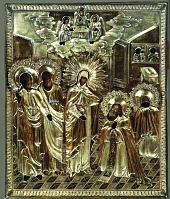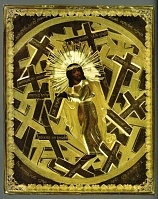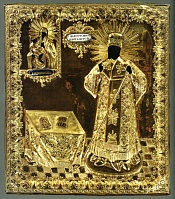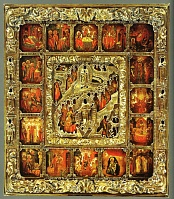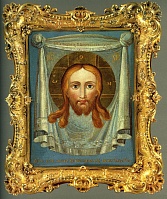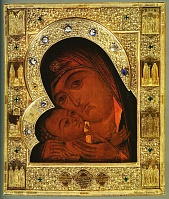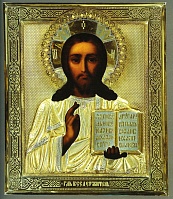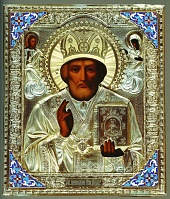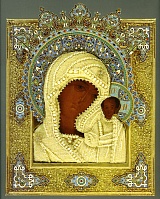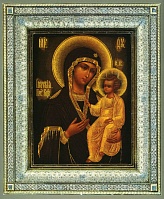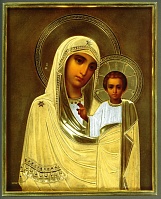The 18th – 19th Century Icons
Icons in icon-frames from the Trinity-St. Sergius Lavra form a significant part of the 18th – 19th century Museum collection. They were actively used in church services, especially during religious processions. Painting, gold and silver icon-frames with haloes looking like large crowns with pearl ornaments and pendants of precious stones were integral. The precious icon-frame turned into a reliquary, “protecting” the sacred image of the icon. So, icons in precious frames can be regarded not only as paintings, they are works of Russian silversmiths of the late 17th – early 20th century.
The Period of Generation of the Baroque Style. Late 17th – Early 18th Century
The icon-frames appeared in the 14th century. The medieval frames were composed of four plaques. The plaques were connected by laying one on another or joint at right angles regardless of the ornament lines. At the late 17th century, there prevailed plates, joined at an angle of 45 degrees. At the periphery of the frame there also appeared “pipes”- relief rollers with volumizing wood chips beneath. In the second half of the 17th century, high pipes appeared simultaneously with the development of the Baroque style in Moscow. Those pipes were often richly ornamented ("Our Lord the Saviour»). The last quarter of the 17th century is characterized by the use of pearl stringing in combination with drilled stones ("The Virgin of the Passion").
The central element of the mounting was a halo. The 17th century haloes had “crowns” (“The Virgin of Kazan”(79)). At the turn of the 18th century, the nimbus plaque achieved the maximum size, exceeding other parts of the frame. The halo decoration reached its peak. At the very end of the 17th century, there appeared another kind of nimbus, consisting of lance-shaped shining rays (“The Virgin of the Sign”).
As in other kinds of applied art, in icon-frame decoration there were used familiar schemes and variations based on them. The decorative ornaments of the late 17th century icon-frames can be divided into several groups. The first group of icon-frames is characterized by splendid and elaborated designs, determined by the strict grouping of the so-called stems, reflecting stylistic features of the Naryshkin Baroque (“The Virgin of Smolensk”).
The second group includes icon-frames decorated with ornaments, based on a curved branch with sprouts, small figured leaves and huge fruit (“The Virgin of Kazan”).The third group comprises icon-frames with patterns that could be attributed as “grape-vine”. They were usually made in embossing.
The fourth group includes a few icon-frames, decorated with engraving in combination with chasing and enamel. The frame of “The Nativity of the Holy Virgin” is decorated with an engraved ornament of a realistically treated wavy sprout, characteristic of earlier medieval art. The so-called smooth frames were new in the late 17th – early 18th
century. The collection of the Sergiev Posad Museum includes about 50 such icon-frames. They are remarkably varied, their amount in the Monastery cathedrals demonstrates decisive observation of innovative artistic practice (“St. Sergius of Radonezh”, “The Virgin of the Passion”).
In the late 17th century, there spread the so-called solid icon mountings, made of a single metal sheet with cut out faces and hands or full figures of the saints. The solid mounting connected the frame, background and robes. The crowns and crescent collars were still plated. (“The Virgin of Kazan”). The surface of the solid mounting and the background permitted free decorative varieties, and artists created original ornamental compositions. Practically all solid icon mountings were made in chasing - the most expensive and complicated technique, demanding only the master’s work. They frequently had the author’s mark.
In the first half of the 18th century, the Petrine decorative schemes in icon mountings developed and differentiated. A new plastic treatment of the Moscow Baroque heritage could be traced at the turn of the 18th century (“The Virgin of Vladimir”). The small thick ornament was abandoned. It was replaced by large heavy forms of the European Baroque. The traditional pattern of a curved branch with sprouts, leaves and fruit was changed. In general, the floral patterns of that time became figurative, plastic and closer to nature (“Our Lord the Saviour”, “The Virgin of the Passion”).
In the mid-18th century, reappeared the nearly forgotten patterns with wavy sprout, sometimes supplemented with fashionable elements: shells, S-shaped curls, etc. (“St. John the Warrior”). The curved branch with small leaves, decorating the margins and filling the frame, was broken by small, multi-petal flowers in the corners and side centers.
The Rococo Style. Third quarter of the 18th century
In the third quarter of the 18th century, the European Rococo, symbolizing the development of ornamental conception, occupied the leading position. In the icon adornments this style appeared in a selection of characteristic elements, combined with the traditional floral pattern. Compared to the Baroque patterns, the ornamental details were more fragmentary and detached, gradually becoming the main compositional elements. Each fragment was composed of a large center surrounded by a group of small details.
The mixture of fundamentally different and expressive tendencies, their rhythmic and figurative combinations made the style fantastic and boundless. In the rocaille (grotto work) mountings the borders of the frame and the background were indistinct, they were sometimes marked only by a thin chased line. The central plaque was practically smooth, and the main patterns covered the edge
From the Rococo to Classicism. Last quarter of the 18th century
The pure Rococo Style was not significant in the icon-frames. On the one hand it approached the Baroque decorations, on the other hand, since the 1780s, it reflected features of the developing Classicism in numerous variants (“The Virgin of the Sign”). The rocaille waves and flowers were used together with garlands, bows, palm branches, flowerpots of intricate configuration. Then the classical element was gradually reinforced (“St. Nicholas the Miracle Worker”).
At the time, when the silversmiths, as all applied artists, almost simultaneously mastered two artistic systems, it was hard to trace, which style brought various decorative elements (“The Virgin of the Passion”). The classical features evidently prevailed in the gilded icon mounting with strasses for “The Virgin of Kazan”. A lot of the 18th century icon-frames were made in chasing, that seemed the most adequate technique for the Baroque and Rococo shape treatment.
The Period of the Developed Classicism. Late 18th – early 19th century
At the end of the 18th century, the superb technical level of Russian silversmiths allowed to cope with any professional task. All icon-frames of the late 18th century were decorated with traditional ornaments of grape-vine with sumptuous leaves, large flowers and fruit occasionally including classical elements: flower-pots, garlands (“St. Antipas of Pergamum”).
The Empire style. First Three Decades of the 19th century
The Empire style is usually regarded as a finishing stage of Classicism of the first three decades of the 19th century. “The Appearance of the Virgin to St. Sergius of Radonezh” is one of the most distinguished samples of the Empire period. The chased icon with painting, showing only in the holes for faces, hands and feet. The main artistic method is a contrast between wide surfaces of shiny and mat gilded silver.
Compared to the late 18th century patterns, the repeating elements were smaller in size and extremely schematic (“Bearing the Cross”). The decoration of neighboring elements became more diverse with the help of punching, polishing, chasing, that made silver chromatic. In this respect, the frame of 1831 for the icon “St. Demetrius of Rostov” is exceptionally remarkable.
The Middle of the 19th Century
The Eclecticism is a synonym of the 19th
century culture, its followers deliberately borrowed the artistic principles of different epochs. In 1840s – 1850s, the icon-frames were preferably decorated according to the baroque and rococo heritage. In the mid-19th
century, those styles, previously having distinct time characteristics, were combined by the selective use of certain decorative elements. Turning to the baroque features could be regarded as a reaction to the simple icon-frame decoration of the Empire period. But a lot of specimens of the early Historicism had mixed decors, the Rococo reminiscences prevailing (“The the Resurrection”, “The Holy Face”).
In the 1860s, the Renaissance and Baroque borrowings dominated, they perfectly suited the design of icon-frames (“The Virgin of Dnepr”). Rather unified, yet individual, they had bright artistic characteristics. Many works of this group were decorated with incredibly thick multipart compositions reminding the so-called “Renaissance” patterns of the 17th century (“The Old Testament Trinity”).
The Russian Style. 1870s – 1890s.
Eclecticism is the main method of the so-called “Russian style”. During the reign of Alexander III (1881 – 1894) the works of the 17th century Moscow and Yaroslavl art were recommended as sample pieces, representing really national art. Ancient art was polychromatic, so colorful enamel was actively inserted in the icon-frames (“The Holy Martyrs Adrian and Natalia”). Last three decades of the 19th
century were characterized by the reference to the ancient monuments following the Byzantine traditions. The large leaves and palmettes, outlined by spiral tendrils, reminded the 13th
– 15th century ornaments. In the solid icon-frames the “Byzantine” patterns decorated only the borders, stressing the medieval function of a mounting, as a frame lining (“St. Nicholas the Miracle Worker”).
All 19th century icon-frames in the Russian style were marked by a tectonic subordination of details, first the decorative emphasis was placed on the frame and then on the crown. The background (or the central part) always remained neutral, its shiny metal was covered with engraving or mechanical guilloche (“The Virgin of Kazan”). Borrowed details helped to create the original appearance of the icon-frame remarkable for the integral artistic design and independent décor.
The Modern Style. Late 19th – Early 20th century
The task of the Modern style was to create a décor as an integral part of the icon image. The first stage of the Modern style was distinguished by the national peculiarity. In contrast to the Russian style of the 19th
century, this stage was called the Neo-Russian style. Its first step was connected with the Abramtsevo circle of artists. The fairy-tale, epic and fabulous world first of all penetrated into the model structures and subjects. Its ornaments were close to the Modern style patterns, inspired by natural images.
The Modern style did not completely reject retrospection, bringing it closer to the 19th century Historicism. It was most expressive in relation to the Neo-Classicism, extensively reflected in icon-frame ornamentation. In close neighborhood the magnificent enamel mountings were quite different from strict and simple icon-frames, surpassing the Empire samples in modesty.









